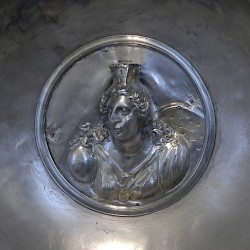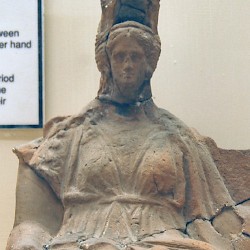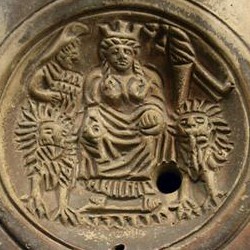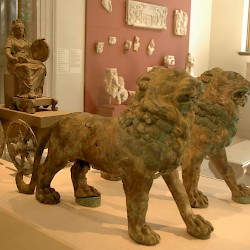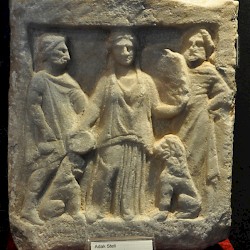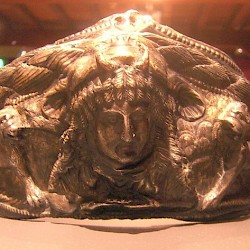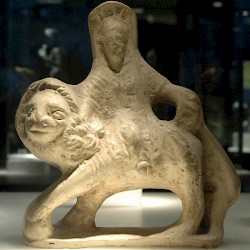Cybele
Cybele (Greek Κυβέλη): Anatolian mother goddess, also worshipped in Greece and the Roman Empire.
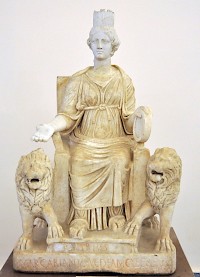
The Great Mother was the goddess who had once given birth to the other gods, to the first humans, to the animals, and to the wild nature. In short: she was the universal mother. (It must be noted that as goddess of birth, she was not the goddess of fertility itself.) The cult of this goddess was ubiquitous in first millennium BCE Anatolia. As Leto, she was venerated in Lycia; the Ephesians called her Artemis; in Hittite sources, we meet the Hurrian goddess Hepat. Matar, Agdistis, and Cybele are the goddess’ Phrygian names. The last name would become predominant in the fifth century BCE.
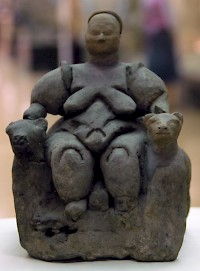
These cults may be very ancient: statuettes of women with large breasts and tummies, found in Çatalhöyük and Hacilar, suggest that mother goddesses were already worshipped in the seventh and sixth millenniums BCE. A statuette of a woman given birth, found on Cyprus, may be evidence of a more widespread cult. However, the First Law of Archaeology applies and other interpretations are also possible. It must be stressed that a real religious continuity of more than 5,000 years is hard to prove. These Prehistoric works of art ar intriguing but difficult, perhaps impossible, to connect to the cults of the first millennium BCE.
Anatolian Deity
The first uncontested evidence for the cult of Cybele, still called Kubaba, comes from Karchemish, the Neo-Hittite city on the Middle Euphrates. Another early cult center was Mount Dindymon in eastern Phrygia. In nearby Pessinus, at the foot of the mountain, the goddess, named Matar and Agdistis, was worshipped as a large black stone, a baetyl. (An obvious parallel is the cult of Aphrodite in Old Paphos.) Although Phrygia was controlled by the kings in Gordium, by the Lydian kings in Sardes, by the Achaemenid Persians, and by the Seleucids, the priests of Cybele in Pessinus managed to remain some independence well into the Roman age.note
 Karchemish, Neo-Hittite relief of Kubaba |
 Gordium, Relief of the great Mother Goddess |
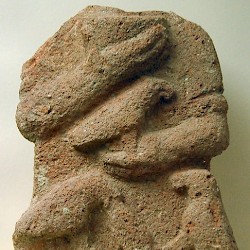 Gordium, Broken statue of Matar |
 Hattusa, Statue of Cybele/Agdistis |
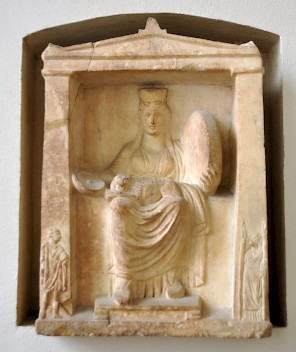
Perhaps the Phrygians, who had come to Anatolia from Thrace in the Early Iron Age, introduced aspects of the Thracian cult of Dionysus: in any case, the rituals were ecstatic in nature. This was of course fitting for a goddess of the wild nature. One of these rituals was the self-castration of (some of) the priests, the galli, which was notorious in the ancient world. They did this to emulate Attis, the beloved of Cybele, who had cut off his genitals in a state of religious frenzy. Seated under a pine tree, he had bled to death.note
One of the main ceremonies, best known from Greek and Roman sources, was celebrated at the beginning of Spring, in March. The devotees cut a pine tree and brought it to the temple. Here, it was decorated with violets, which represented drops of Attis' blood. The high priest made a cut in his arm and offered some blood to the goddess. The other priests were dancing and whipping themselves, so that drops of their blood fell on the holy pine tree.
Greek Goddess
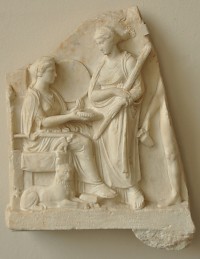
Greek and Romans authors, unaware of the worship in Karchemish, generally state that the cult of Cybele originated in Phrygia; in fact, this was the center from where the cult spread to the west. One of the stations in between may have been Sardes in Lydia, which had a temple of Kubaba.note
The Greek worshippers believed that she was identical to their own Rhea, the mother of the Olympian gods and goddesses Hestia, Demeter, Hera, Hades, Poseidon, and Zeus.note This facilitated the spread of the new cult, which was already known in Locri, in southern Italy, at the beginning of the sixth century BCE. The Greeks were intrigued by the ecstatic rites of Cybele, who is usually called “the great mother of the gods”,note but she never became part of the common mythology, which had already been canonized by Homer and Hesiod.
The most common representation of the goddess was, until then, a relief of a standing lady (see above for two examples from Gordium), or a relief of seated lady (below: examples from Apollonia and Kallipolis). In the last quarter of the fifth century BCE, the sculptor Agoracritus of Paros created a new type: a crowned Cybele holding a large tambourine in her left hand, seated on a throne, between two lions. This statue, which stood in the temple of the Great Mother in Athens,note was to remain the normal iconography for centuries to come. See the statue from Ostia above, at the top of this page, and the statue from Formia below.
 Apollonia, Relief of Cybele |
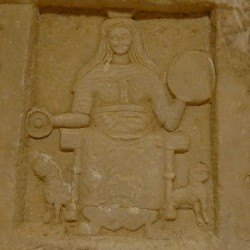 Kallipolis, Relief of Cybele |
 Tenedos, Figurine of Cybele |
 Pergamon, Statue of Cybele |
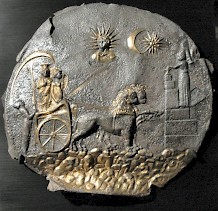
The two lions were supposed to be the draft animals of Cybele’s chariot. They are seen on a splendid silver disk from Ai Khanum in faraway Bactria, where the goddess is shown, moving towards a Zoroastrian shrine, with a Babylonian-style Sun, Moon, and Venus in the sky.
When this disk was made, Galatian tribes were invading Anatolia. One of these, the Tolistobogii, captured Pessinus and made it their capital (c.270 BCE). In 238 and 230, they were defeated by the Pergamene king Attalus I Soter. The cult statue of Cybele, the baetyl mentioned above, was brought to Pergamon. Here it stood in the Megalesion, the sanctuary of the Great Mother, that was built by the founder of Attalus’ dynasty, Philetaerus.
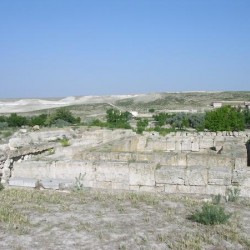 Pessinus, Sanctuary |
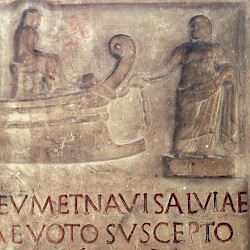 Rome, Tiber, Relief of Claudia Quinta |
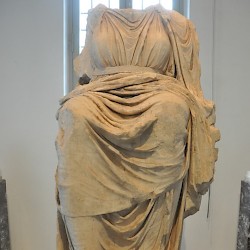 Rome, Palatine, Temple of Cybele, Statue |
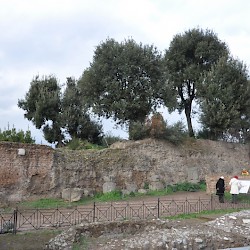 Rome, Palatine, Temple of Cybele |
Roman Goddess
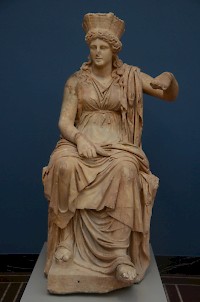
During the Second Punic War, the Romans learned from an oracle that they would not be able to defeat Hannibal until the “Great Mother of Mount Ida” had been brought to Rome. So, in 204, the Romans sent an embassy to Pergamon, and requested the holy stone, which was brought to Rome. Because the Roman historian Livy tells that Roman matrons, "each taking their turn in bearing the sacred image, carried the goddess into the temple of Victory,"note it is likely that in fact just a part of the sacred object was brought to Rome.
A later legend told that a Roman lady named Claudia Quinta, who had been accused of unchastity, proved her innocence by towing the ship with the goddess single-handedly to the city.note The stone was originally in the temple of Victoria but was later transferred to its own sanctuary, the temple of Cybele. Both cult places were on the Palatine hill, in the center of Rome.
The frenzied ceremonies were a bit too much for the Romans and at first, Roman citizens were forbidden to act as priests in those unRoman rituals. This ban was lifted after three centuries by the emperor Claudius (r.41-54), who put the Spring festival on the Roman calendar. Another adaptation was the renaming of the Great Mother: she was now the Great Mother of Mount Ida, which made her a Trojan deity and worthy of Roman veneration.
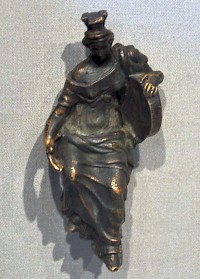
Beside the Spring festival of Cybele and Attis, the Romans celebrated the Megalensian Games. On the fourth of April, the praetor urbanus would sacrifice, there were festive meals, and lower magistrates brought the silver cult statue with the holy stone in a chariot to the Almo (a small river near the Via Appia), where they washed it.note
Except for the Spring festival and the Megalensian Games, the Roman devotees of Cybele celebrated initiation rites. These are associated with the Taurobolium ceremony, which appears to have involved the sacrifice of a bull. It is unclear whether this ritual was a Roman innovation or a survival from the Anatolian stage of this cult, but it is remarkble that there is no evidence for this ritual before the reign of Hadrian (r.117-138.).note
The bloodly sacrifice was an easy target for Christian authors,note although the cult of Cybele appears to have continued until the early fifth century: in one of his letters, Synesius of Cyrene, a nobleman from the Cyrenaica who would become bishop, compares someone's headdress to that of Cybele, as if everybody knows the annual procession of her cult statue.note
